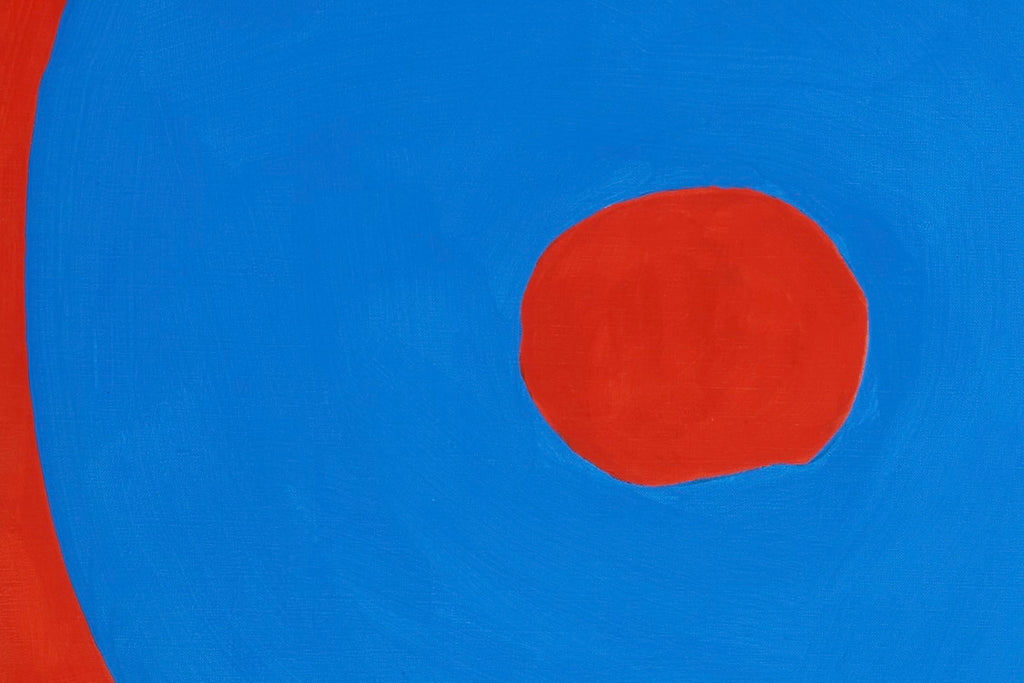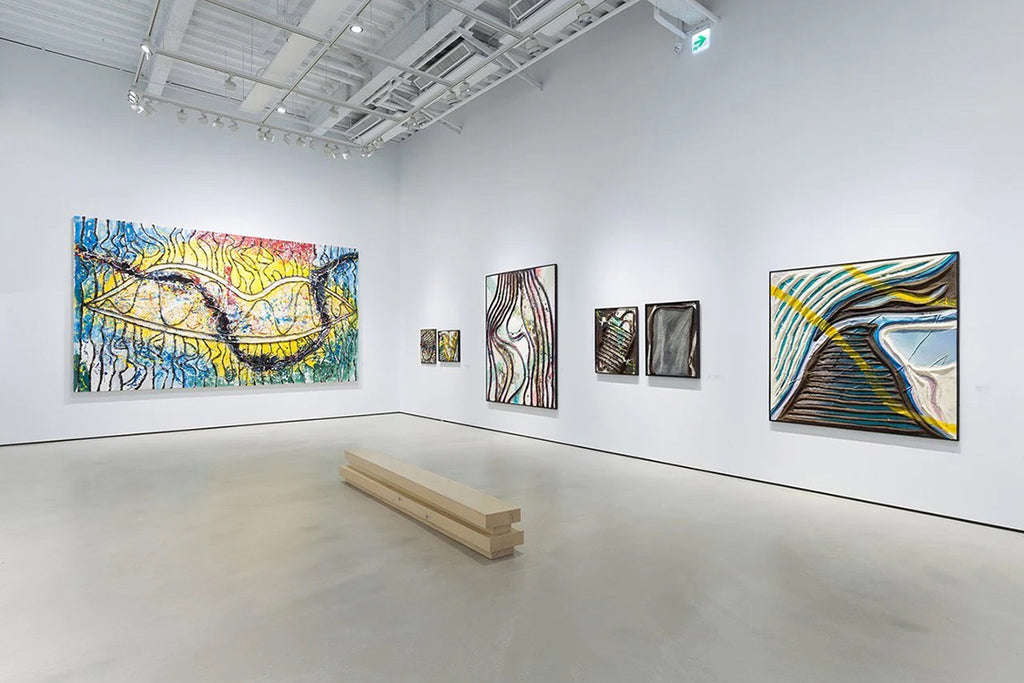ARTICLES
Painting that Does Not Resemble to Anyone Else’s Expression that Reaches the Deepest Layer of the Heart
A New Appreciation Contemporary Japanese and Asian Art
21/23

“KATSUYOSHI INOKUMA: Cosmic View of Earth” Whitestone Ginza New Gallery, 2019
In our ongoing series, we present the digital archive of the book 'A New Appreciation Contemporary Japanese and Asian Art' This book delves into internationally acclaimed artists and the dynamics of the Asian art market. The twenty-first installment features artist Katsuyoshi Inokuma and art critic Kunio Motoe.
Painting that Does Not Resemble to Anyone Else’s Expression that Reaches the Deepest Layer of the Heart|Interviews of Experts in the Art Industry
Katsuyoshi Inokuma
Artist
Kunio Motoe
Professor Emeritus, Tama Art University and Art Critic
Katsuyoshi Inokuma is a painter based in Koriyama, Fukushima, who creates his artworks and releases them mainly at his solo exhibitions. He says, “(I want to make) works that enter people’s minds as deep as possible to the bottom layer.” Inokuma explores his artistic practice with spirit, “not pushing what I want to say, but pursuing the expression on which the viewer’s memory resonates with the work.” He has achieved mysterious and lyrical art composed of simple space composition and layers of forms colored in black and blue. This is Inokuma at his best. At his solo exhibition (Whitestone Gallery Ginza, 2019), Mr. Motoe interviewed the artist focusing on him and his art.
Receiving the Grand Prix at the Memorial of Aoki Shigeru Art Biennale
What Supported Him During Difficult Times
Motoe: You received the grand prix at the Memorial of Aoki Shigeru Art Biennale in 1996. Since then, you have been based in Koriyama and continue your practice through solo exhibitions. When did you first think of becoming an artist?
Inokuma: I decided to be one very late, probably after I turned forty. My turning point was being laid off from the company I was working for.
Motoe: You had gone through such hardships. Didn’t you want to be a painter when you were in your twenties?
Inokuma: I never expected to make a living by painting. I at least had a little common sense (laugh). But I still wanted to go to the Tokyo University of the Arts. My parents did not allow us to go to private schools. So, I attended a preparatory school while working. I tried the exam five times and still could not make it.
Motoe: After being laid off, did you think of finding another job?
Inokuma: I was not good at working in an organization. And finding a company that hires someone over forty years old as a full-time permanent employee was very difficult. After all, painting was the only thing I could do.
Motoe: That must have been a very difficult situation.
Inokuma: Yes. Although my wife worked and supported me, we went through very difficult times economically since we had three school-age children. I tried to run painting lessons, which only made me realize that I have no talent in teaching. Motoe: Have you ever thought of quitting painting?
Inokuma: Several times until I received the award at the Memorial of Aoki Shigeru Art Biennale. The award came when I was going through the worst times. When I did not have work, I started drinking in daytime. I was very lost. That was when I obtained the news that I had received the award.
Motoe: I am glad.
Inokuma: Yes, our savings were about to run out, too.
Motoe: Did your condition as a painter become better?
Inokuma: Yes. The newspaper featured the award news. No galleries dealt with me until that point, but they became approachable, which made it easier to do solo exhibitions. While the award added one line to my resume, it caused a drastic change. Although I was treated like nobody, I actually visited the galleries in Tokyo to promote myself….
Motoe: Have you ever thought of making figurative paintings like landscapes and flowers?
Inokuma: Never. There are many high-level figurative painters with whom I have no way to compete. I also wanted to create something only I can paint.
Motoe: Your current situation was made possible with the support of your family. Inokuma: I owe them much and am truly thankful. I really feel that I am blessed with people like the collectors who continue to buy my works and the supporters who help me with the publications and websites.
Motoe: It must be because you have continued without giving up. Only a few continue painting even if they manage to graduate from art school. It is a very tough challenge. Furthermore, even if you are not famous, you will still find your supporters if you create inspirational works. It is a great thing.
Inokuma: Yes. Talking with you today was also made possible with the help of supporters. It is really like a dream.
Blue, Space, and Smoke from Oven
Motoe: Have you been painting abstract since the beginning?
Inokuma: There was a time when I tried portraits, but the human face changes if the tail of eyes move even one millimeter. I just got tired of it one day.
Motoe: Does it mean you wanted to be free from objects?
Inokuma: Yes, and I gradually moved to abstract. But abstract painting is hard to sell. Therefore, I seriously strategized the sale of my works. After all, painting was the only future for me.
Motoe: That sounds interesting. What did you decide on?
Inokuma: My conclusion was that people will not spend their money unless the work touches their heart and enters the deepest layer of their heart.
Motoe: The work needs to move people’s heart.
Inokuma: Yes. To do so, I must achieve an expression that resonates with the viewer’s memory, instead of delivering what I want to say.
Motoe: I see. When you are painting, what is the most important thing to you? For instance, is there something you devise?
Inokuma: It is the treatment of the edges, that is, how to treat the boundary between forms and colors. I intuitively found it important and thought a lot on whether to make the edge as sharp as if it were cut with a knife, or to make it blurry like Mark Rothko.
Motoe: In fact, your work does feel emotional. Both the forms and colors are touching and comforting. By the way, you just mentioned the name, Mark Rothko. Do you have any other favorite artists?
Inokuma: I like Rembrandt Harmenszoon van Rijn. I also like Odilon Redon.
Motoe: What of Redon do you like?
Inokuma: I like his black and cerulean blue, and the feeling attached to the space. It is naïve and mysterious at the same time.
Motoe: I have seen some of your works. Many of your works use blue.
Inokuma: Blue, black, and white are colors that give us a sense of space that expands far away. I like Redon’s black and white margin of the ink-painting. But blue has been my favorite. It adds depth to the space.
Motoe: Why do you think the space matters so much in your work?
Inokuma: I hated walls since I was small. I did not like having my vision blocked. On the contrary, my favorite space was what I found in the scenery that I saw from the nearby mountain-top.
Motoe: It sounds interesting. What kind of scenery was it?
Inokuma: It was back when rice was still cooked in a cooking stove. In the evening, smoke rose from every home and drifted away. I really liked that scenery. I think it surely influenced my art, which led me to pastel and acrylic works.
Motoe: In terms of numbers, you use limited number of colors. What is the process of painting?
Inokuma: There are two types of works: acrylic and pastel. When making acrylic paintings, I start by making a colored foundation.
Motoe: You add more colors on the foundation, correct?
Inokuma: Yes. I then scrape the top layers. In my work, this act of scraping is very important.
Motoe: How do you scrape?
Inokuma: I use sanded papers. And, I paint again. My art is made through repeating these processes.
Motoe: I see… that process creates a unique color.
Inokuma: I used to use canvas as the support medium. However, the canvas stretches as I scrape the paint, which deforms the work. Therefore, I now use veneer plywood as the supporting medium and apply gesso on the surface.
Motoe: You also scrape your pastel works.
Inokuma: Yes, I scrape the paper to create a rough surface.
Motoe: I see. It is obvious when the work is under a light. Some parts are thinner than others. What effect does creating a rough surface have?
Inokuma: Pastels stay on the paper much better.
Motoe: How do you make your pastel works?
Inokuma: I grind pastels in a mortar and use my fingers to draw.
Motoe: You do not use brushes. Interesting….
Inokuma: I wanted to use my own method and create my own painting that does not look like anybody else’s. That was the only reason.
Motoe: Since acrylic takes a little while to dry, the process must be different from that of pastel works.
Inokuma: Yes. Pastels can be worked on without a break. But since I keep touching the rough surface of the paper with my fingers, my fingers eventually get burnt if I work too long (laugh).
Motoe: Do you spend long hours painting?
Inokuma: I do not think I spend that much time working with paints. I may be spending more time looking at the works. In my case, I tend to feel motivated around four o’clock in the afternoon.
Motoe: Why is that?
Inokuma: The routine of “starting to drink at six” is in my bones. But this does not happen all the time if I start self-criticizing my work (laugh).
Motoe: Do you have any living artists from whom you received any influence? Inokuma: There is no one close to Rembrandt or Rothko, but I was inspired by Chiyu Uemae whom I recently found out about. His works are great.
Motoe: Mr. Uemae’s works are, in fact, very unique in the Gutai Art Association. I, too, found out about him recently.
Inokuma: While many Gutai artists have energetic styles, Mr. Uemae stands as a “silent” existence. It can be said that he is a pure artist who understands what it means to subtract. His use of materials is also great.
Motoe: I agree completely. Seeing your actual works today allowed me to experience your unique abstract expression with high spirituality that is reflected in the unique colors and sensitive surface textures. I also felt, once again, the importance of seeing the actual works. I look forward to your solo exhibition in autumn. Thank you very much.
Inokuma: Thank you very much. I am very glad to have been able to talk with you on various topics.
(Reprinted from Gekkan Bijutsu 【Monthly Art】, October 2015)
Book Information
Title: A New Appreciation Contemporary Japanese and Asian Art (English Edition)
Publisher : Whitestone Co., Ltd.
Release Date : February 26, 2020
*Information in this article is at the time of publication.



